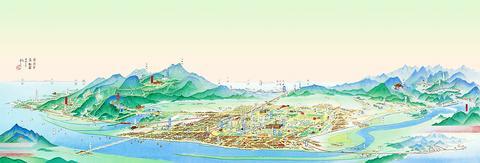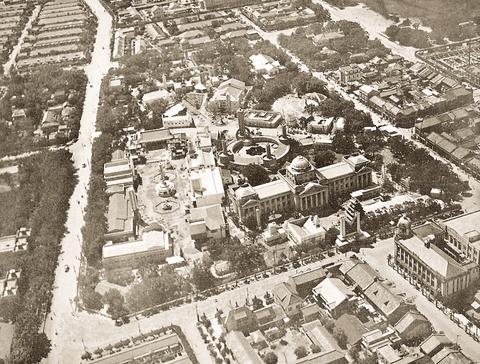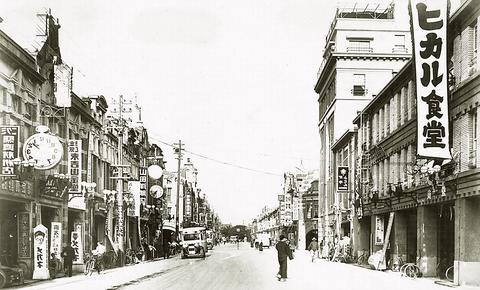Built atop an alluvial deposit-filled lake, Taipei City may not be one of the world's most picturesque metropolises and it might not be one of the oldest, but on Aug. 22, when the city celebrates its 120th birthday as the nation's economic and political nucleus, the city government hopes to remind Taipei residents that amid the urban sprawl lays a rich historical legacy.
Originally home to Taiwan's plains-living Aboriginal peoples, the basin that now cradles the nation's capital was first settled by ethnic Chinese from Fujian Province in the early 1700s. Records show that in 1709 a group of Fujian residents petitioned to Qing officials in a bid to open up land adjacent to the Tamsui River for development.

The first settlers arrived that same year and established settlements in and around what is today the Taipei suburb of Hsinchuang.

PHOTO COURTESY OF SMC PUBLISHING
By the mid-1800s, Wanhua, or Manka (
As the area's largest seaport, Dadaocheng and the surrounding area soon became Taipei's economic hub and prospered through trade in rice and teas. Quick to realize the benefits of amalgamating the trade zone with the numerous surrounding settlements for administrative purposes Qing officials established the municipality of Taipei Prefecture, or Taipei Fu (

The idea of relocating Taiwan's capital to Taipei first came into fruition in 1882, but it wasn't until Aug. 22, 1884, when Taiwan's first governor, Liu Ming-chuan (劉銘傳), relocated his offices to Taipei Fu and declared Taipei the new capital.
Liu created an administrative infrastructure that included the building of government offices and schools and commissioned the construction of a city wall.
Like many of the original Qing structures, the city wall was demolished for military and sanitary reasons in 1895 on the orders of Japan's first colonial governor, Motonori Kabayama. Over the next 40 years, Taipei was to lose much of its Qing tradition and was instead transformed into modern city with an up-to-date sewer system and countless engineering projects that saw Japanese architecture become the face of the new Taipei.
Successive decades of development have meant that many of the Qing structures that survived the Japanese have long disappeared and large numbers of Japanese colonial buildings have met with the wrecking ball and been replaced by modern edifices. The Taipei City Government's Cultural Affairs Bureau has attempted to stem the tide of what was, until as recently as four years ago, the widespread and unrestricted demolition of historical buildings.
"Until the late 1990s large numbers of old buildings were demolished by landowners illegally, but in the past three years the number has dropped significantly," said Wang Yi-chun (王逸群) of the city government's cultural bureau. "Landowners who demolish historical buildings now face a fine. And while the fine is a minimal NT$30,000, any landowner who demolishes such a building is now forbidden by law to build any other structure on the site."
While the bureau admits that not all of the city's old buildings can be saved, its policy has resulted in a huge increase in awareness regarding the need to protect the past.
"When the bureau was first tasked with the job of saving historical buildings, the picture was pretty grim. But with a full-time committee now working to preserve the sites, the number of buildings that are classified as heritage sites is at an all-time high," he said. "Public campaigns that promote the policy have meant that a lot more people are aware of the need to preserve the city's history."
Since the city government's culture bureau established its heritage-sites program and instituted a policy that restricted the demolition of historical sites, the number of protected structures throughout Taipei has risen to 120 and there are over 2,000 structures, that, while not protected by the law, are considered to have important historical significance.
"The criteria for what constitutes a heritage building is set by a committee that assesses buildings based on their cultural and historic values. Common buildings, such as the many Japanese colonial residences, are not considered as important as buildings with historical connections," said Wang.
"As long as they have historical significance, we put them on the list of protected buildings."
Some examples which show how much effort the city has put into the renovation and preservation of the city's historic buildings include the Chian Mu Residence (錢穆故居), Lin Yu-tang Residence (林語堂故居), the former residence of the American ambassador, or as it is now known, the Taipei Film House (台北之家) and the Yuanshan Villa, or the Taipei Story House, which sits adjacent the Taipei Fine Arts Museum.
The city government hopes that the series of events and exhibitions that are set to take place over the coming months in celebration of city's 120th anniversary can raise awareness of the need to preserve historic structures and prove to city residents that Taipei has a valuable history.
Current exhibitions related to the city's history include the Discovery Center of Taipei (
Up coming events include a partial renovation of the old city wall in September and a day-long festival and carnival in October.

May 18 to May 24 Pastor Yang Hsu’s (楊煦) congregation was shocked upon seeing the land he chose to build his orphanage. It was surrounded by mountains on three sides, and the only way to access it was to cross a river by foot. The soil was poor due to runoff, and large rocks strewn across the plot prevented much from growing. In addition, there was no running water or electricity. But it was all Yang could afford. He and his Indigenous Atayal wife Lin Feng-ying (林鳳英) had already been caring for 24 orphans in their home, and they were in

On May 2, Chinese Nationalist Party (KMT) Chairman Eric Chu (朱立倫), at a meeting in support of Taipei city councilors at party headquarters, compared President William Lai (賴清德) to Hitler. Chu claimed that unlike any other democracy worldwide in history, no other leader was rooting out opposing parties like Lai and the Democratic Progressive Party (DPP). That his statements are wildly inaccurate was not the point. It was a rallying cry, not a history lesson. This was intentional to provoke the international diplomatic community into a response, which was promptly provided. Both the German and Israeli offices issued statements on Facebook

President William Lai (賴清德) yesterday delivered an address marking the first anniversary of his presidency. In the speech, Lai affirmed Taiwan’s global role in technology, trade and security. He announced economic and national security initiatives, and emphasized democratic values and cross-party cooperation. The following is the full text of his speech: Yesterday, outside of Beida Elementary School in New Taipei City’s Sanxia District (三峽), there was a major traffic accident that, sadly, claimed several lives and resulted in multiple injuries. The Executive Yuan immediately formed a task force, and last night I personally visited the victims in hospital. Central government agencies and the

Australia’s ABC last week published a piece on the recall campaign. The article emphasized the divisions in Taiwanese society and blamed the recall for worsening them. It quotes a supporter of the Taiwan People’s Party (TPP) as saying “I’m 43 years old, born and raised here, and I’ve never seen the country this divided in my entire life.” Apparently, as an adult, she slept through the post-election violence in 2000 and 2004 by the Chinese Nationalist Party (KMT), the veiled coup threats by the military when Chen Shui-bian (陳水扁) became president, the 2006 Red Shirt protests against him ginned up by